Category: Exoplanets
-
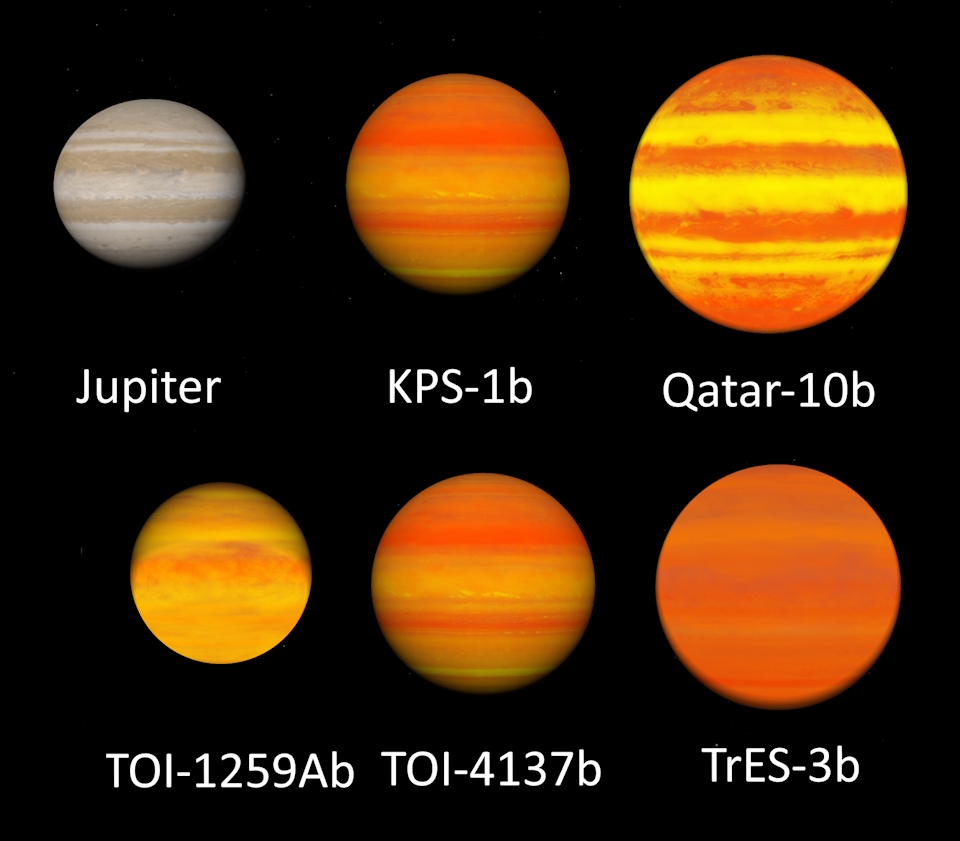
Reproducibility of transit light curves for the detection of exoplanets
The transit light curves of five exoplanets are evaluated for their reproducibility. The parameters examined are the indirectly measured radius of the respective planet and the temporal center of the transit. After a detailed treatment of the individual exoplanets, a summary of the measurements shows that the respective planetary radius was measured reproducibly in 10 of 12 measurements.
-
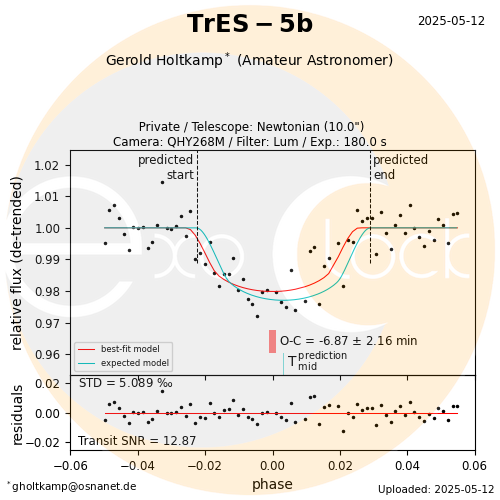
Measurement of the transit light curve of the exoplanet TrES-5b on May 11/12, 2025
Der Exoplanet und sein Mutterstern befinden sich im Sternbild Schwan an der Grenze zum Cepheus. Die Messungen erfolgten vom 11.5.2025, 22:13 Uhr UTC bis zum 12.5.2025, 1:57 Uhr UTC in Osnabrück, Sonnenhügel. Der Mond war zwar zu 99 % beleuchtet, aber 104° entfernt, sodass er nicht ins Teleskop scheinen konnte. Er ging am 11.5.2025 um…
-
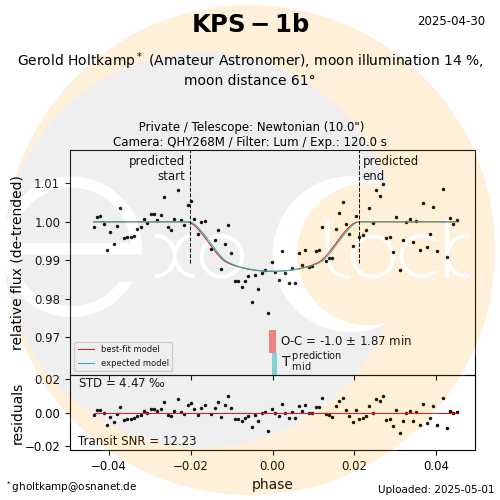
Measurement of the transit light curve of the exoplanet KPS-1b on April 30/May 1, 2025
Der Exoplanet und sein Mutterstern befinden sich im Sternbild Große Bärin. Die Messungen erfolgten vom 30.4.2025, 21:11 Uhr UTC bis zum 1.5.2025, 0:49 Uhr UTC in Osnabrück, Sonnenhügel. Der Mond war zu 14 % beleuchtet und 61° entfernt. Er ging am 30.4.2025 um 4:55 Uhr UTC auf und 23:26 Uhr UTC unter, war aber wegen…
-
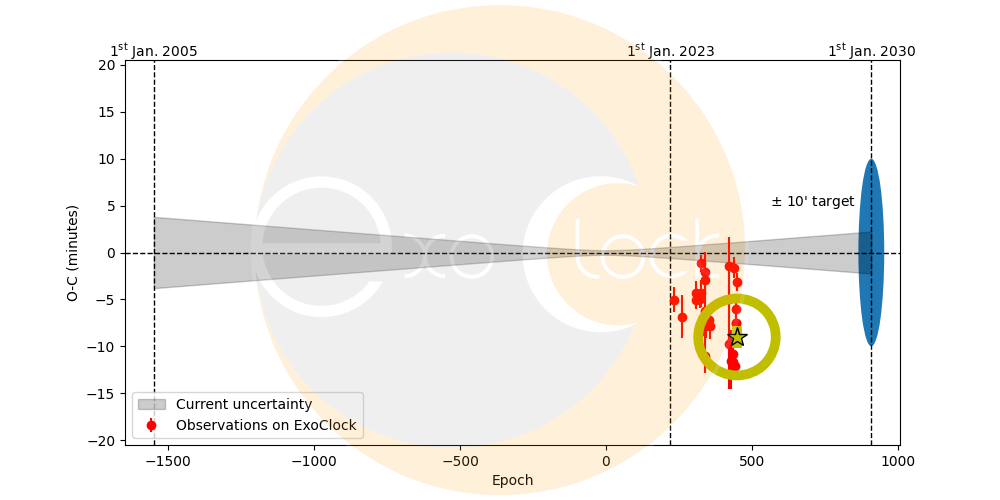
Measurement of the transit light curve of the exoplanet TOI-1811b on April 27/28, 2025
The exoplanet and its parent star are located in the constellation Coma Berenices. The measurements were taken from 23:00 UTC on April 27, 2025, to 2:54 UTC on April 28, 2025, in Osnabrück, Sonnenhügel. The Moon was illuminated at 0.2% and therefore not obstructive.
-
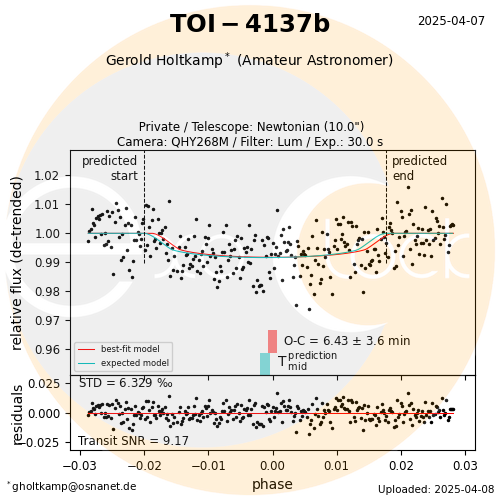
Measurement of the transit light curve of the exoplanet TOI-4137b on April 7/8, 2025
The measurements were taken from 7:26 p.m. UTC on April 7, 2025, to 12:51 a.m. UTC on April 8, 2025, in Osnabrück, Sonnenhügel. The moon was 78% illuminated and 66° distant. It set at 3:24 a.m. UTC on April 8, 2025, and was therefore visible throughout the entire measurement period. It could therefore have shone into the telescope and potentially influenced the measurement accuracy.
-

Transit light curve of the exoplanet Qatar-1b on June 6th/7th April 2025
The measurements were taken from 10:07 p.m. UTC on April 6, 2025, to 2:24 a.m. UTC on April 7, 2025, in Osnabrück, Sonnenhügel. The moon was 70% illuminated and 93° distant. It set at 3:03 a.m. UTC on April 7, 2025, and was therefore in the sky for the entire measurement period. However, because it was 93° distant, it could not shine into the telescope.
-

Measurement of the transit light curve of the exoplanet Qatar-10b on 2/3 April 2025
The measurements were taken from 21:55 UTC on April 2, 2025, to 3:27 UTC on April 3, 2025, in Osnabrück, Sonnenhügel. The moon was 27% illuminated and 64° distant. It set on April 3, 2025, at 0:15 UTC.
-

Measurement of the transit light curve of the exoplanet Qatar-8b on March 31/April 1, 2025
The measurements were taken from 9:26 p.m. UTC on March 31, 2025, to 3:06 a.m. UTC on April 1, 2025, in Osnabrück, Sonnenhügel. The moon was 10% illuminated and 78° distant. It set on March 22, 2025, at 10:30 p.m. UTC. It was therefore not relevant for the measurement.
-

Measurement of the transit light curve of the exoplanet TOI-1298b on March 27/28, 2025
The measurements were taken from 22:32 UTC on March 27, 2025, to 4:27 UTC on March 28, 2025, in Osnabrück, Sonnenhügel. The moon was illuminated at 3% and 101° away. It was therefore not relevant for the measurement.
-

Measurement of the transit light curve of the exoplanet KELT-23Ab on March 21/22, 2025
The measurements were taken from 10:21 PM UTC on March 21, 2025, to 2:37 AM UTC on March 22, 2025, in Osnabrück, Sonnenhügel. The moon was 55% illuminated and 98° distant. It rose at 3:30 AM UTC on March 22, 2025. It was therefore not relevant for the measurement.